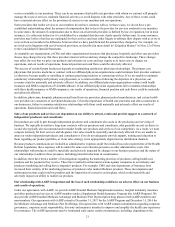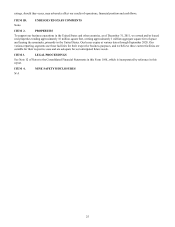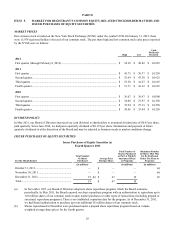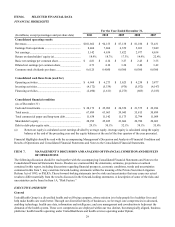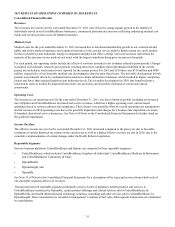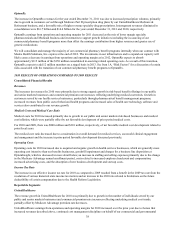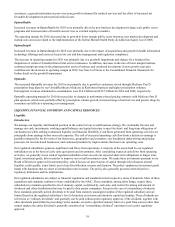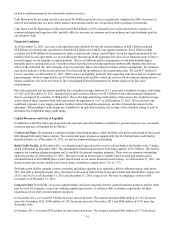United Healthcare 2011 Annual Report Download - page 33
Download and view the complete annual report
Please find page 33 of the 2011 United Healthcare annual report below. You can navigate through the pages in the report by either clicking on the pages listed below, or by using the keyword search tool below to find specific information within the annual report.31
operations.
In 2012, we expect increasing unit costs to continue to be the primary cost driver of medical cost trends and we project steadily
increasing medical system utilization over the course of the year. We also expect an increase in prescription drug costs. We will
continue to work to manage medical cost trends through care management programs, affordable network relationships, pay-for-
performance reimbursement programs for care providers, and targeted clinical management programs and initiatives focused on
improving quality and affordability. Additionally, employers are continuing to select products with benefit designs that shift
more of the costs to the employee. This cost shifting continues to mitigate increases in medical cost trends.
Our businesses focus on affordability, consumer empowerment, wellness and prevention, payment innovations, and enhanced
distribution to better serve our customer and consumer needs and demands. These business objectives are consistent with the
goals of health care reform. We expect that the portion of our costs that is tied to incentive contracts that reward providers for
outcome-based results and improved cost efficiencies will continue to increase. Care providers are facing market pressures to
change from fee-for-service models to new delivery models focused on the holistic health of the consumer, integrated care
across care providers and pay-for-performance payment structures. This is creating the need for health management services
that can coordinate care around the primary care physician and for investment in new clinical and administrative information
and management systems. The impact of such changes on our results of operations is uncertain but, we expect them to
moderate the rate at which medical costs increase. This trend also provides growth opportunities for our OptumHealth and
OptumInsight businesses.
We attempt to price our products consistent with anticipated underlying medical trends, while balancing growth, margins,
competitive dynamics and premium rebates at the local market level. We seek to sustain a stable medical care ratio for an
equivalent mix of business. However, changes in business mix, such as expanding participation in comparatively higher
medical care ratio government-sponsored public sector programs and Health Reform Legislation may impact our premiums,
medical costs and medical care ratio. In 2012, we continue to expect reimbursements to be under pressure through government
payment rates and continued market competition in commercial products.
Regulatory Trends and Uncertainties
In the first quarter of 2010, the Health Reform Legislation was signed into law. The Health Reform Legislation expands access
to coverage and modifies aspects of the commercial insurance market, the Medicaid and Medicare programs, CHIP and other
aspects of the health care system. HHS, the DOL, the IRS and the Treasury Department have issued or proposed regulations on
a number of aspects of Health Reform Legislation, but final rules and interim guidance on other key aspects of the legislation,
all of which have a variety of effective dates, remain pending.
The Health Reform Legislation and the related federal and state regulations will impact how we do business and could restrict
growth and restrict premium rate increases in certain products and market segments, increase our medical and administrative
costs, or expose us to an increased risk of liability, any or all of which could have a material adverse effect on us.
We also anticipate that the Health Reform Legislation will further increase attention on the need for health care cost
containment and improvements in quality, with a focus on prevention, wellness and disease management. We believe demand
for many of our service offerings, such as consulting services, data management, information technology and related
infrastructure construction, disease management, and population-based health and wellness programs will continue to grow.
Following is a listing of some of the key provisions of the Health Reform Legislation and other regulatory items along with
management's view of the related trends and uncertainties that may cause reported financial information to not be indicative of
future operating performance or of future financial condition.
Premium Rebates
Effective in 2011, commercial health plans with medical loss ratios on fully insured products that fall below certain targets are
required to rebate ratable portions of their premiums annually. The potential for and size of the rebates are measured by state,
by group size and by licensed subsidiary.
In the aggregate, the rebate regulations cap the level of margin that can be attained.
The disaggregation of insurance pools into smaller pools will likely decrease the predictability of results for any given pool and
could lead to variation over time in the estimates of rebates owed.
Other market participants could implement changes to their business practices in response to the Health Reform Legislation,
which could positively or negatively impact our growth and market share. Insurers could elect to change pricing, modify
product features or benefits, adjust their mix of business or even exit segments of the market. They could also seek to adjust


